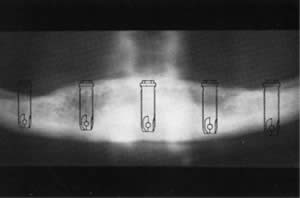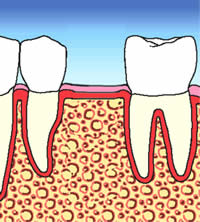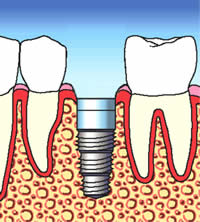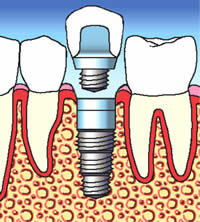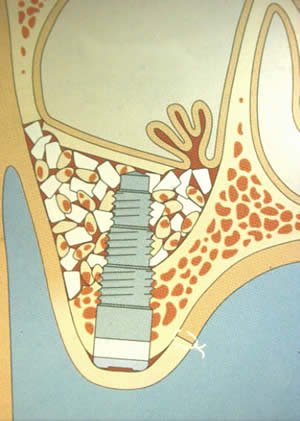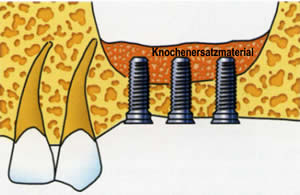
| Dental Implants 1. What is a Dental Implant? 2. How is an Implant Placed? 3. What are Pros and Cons of implants? 4. Is implantation painful? What can I expect after the operation? 5. What is Bone Augmentation? 6. What is a “Sinus Lift”? 7. Are there any Risks and Complications on Implants? 8. How long do implants last? 9. Are implants an option for all patients? 10. How long is the healing period and can I wear a temporary prosthesis during this time? 11. Is smoking bad for implants? 12. Is the quality of all implants equal? 13. What is your opinion of "Fixed teeth in one day"? 14. How must I clean my implants? |
||||||
| Dental Implants | ||||||
| Q : | What is a Dental Implant? | |||||
| A : |
An implant is an artificial root made from a biocompatible material that is implanted to replace lost teeth. Standard implants today are screw or cylinder form made from titanium. Titanium is a unique metal: It can be incorporated in the bone without an intermediate layer. This intimate contact between bone and titanium is called osseointegration. Another advantage of titanium is it does not cause allergic reactions, rejection, nor inflammation of the oral mucosa. Because of its biocompatible qualities, titanium is broadly used for other medical implants, for example hips, knees, etc. Normally, dental implants have a length of 6-15 mm and a diameter of 3-5 mm. On the market there are numerous companies producing implants, but only few systems are supported by scientific studies and long-term results. |
|||||
| Q : | How is an Implant Placed? | |||||
| A : | Careful planning is the first step preceding an implant operation. With help from x-rays and study models, the amount of bone is measured in length and width, so the ideal position for a suitable implant can be planned.
A : Implantation is a surgical intervention performed under sterile conditions that can take between 45-90 minutes. Implantation can be done without pain using local anaesthesia. Nevertheless, the procedure can be stressful for some patients. For this reason, we offer treatment to be done under conscious sedation, using nitrous oxide (laughing gas) or other sedatives. The advantage is complete relaxation and comfort for the patient. For larger operations, like bone augmentation, or for dental phobic patients, we can also offer general anaesthesia. An expert team of anaesthesiologists can accompany us within the Clinic St. Anna, or in our private practice. After the gum tissue is numb, it is carefully opened. With a sequence of calibrated burs, the implant bed is prepared. To prevent overheating of the bone, preparation is done with sterile water cooling. The suitable implant is chosen and placed. The gum tissue is sutured over the implant and a temporary prothesis or bridge is seated.
Uncovering the Implant After the implant has integrated into the bone for 6-12 weeks, a small procedure is performed to expose the head of the implant. This procedure is often done by laser because it guarantees proper wound healing and is almost painless for the patient. After the exposure of the implant head, we take an impression and send it to the laboratory where the prosthetic work (bridge, crown or removable denture) is made. |
|||||
| Q : | What are Pros and Cons of implants? | |||||
| A : |
|
|||||
| Q : | Is implantation painful? What can I expect after the operation? | |||||
| A : | With local anaesthesia the operation is absolutely painless. Upon request it can be done under conscious sedation or general anaesthesia. After the treatment it is normal to feel soreness for a few days. This can easily be controlled with the pain medication. Some visible swelling is normal for 3-5 days, sometimes bruising occurs but will fade rapidly. | |||||
| Q : | What is Bone Augmentation?
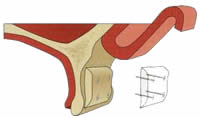 (1) (1) 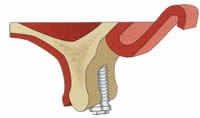 (2) (2) 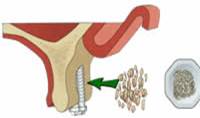 (3) (3) 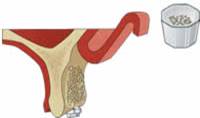 (4) (4) |
|||||
| A : | Narrow bone ridge: Before implantation the bone is built up with Frequently the height or width of the jawbone is reduced by bone atrophy, leaving the existing bone volume insufficient to support an implant. In this situation, bone augmentation is necessary. It can be done before or at the same time of implantation. The best material for bone build-up is the patient's own bone (autologous bone) taken for example from the mandible. Only in extreme cases of bony atrophy a bone graft from an extraoral donor site is needed (for example from the hip). The bone graft is taken as a block and fixed with small titanium screws or is ground into granules and covered with a special membrane. After 6 months, the bone is integrated and the implant can be inserted. For smaller bony defects a bone substitute material (BioOss ฎ ) can be used. Within a 6-12 months period, the patient's own bone will absorb and replace the substitute. Advantage: No bone graft procedure is necessary. |
|||||
| Q : | What is a "Sinus Lift"? | |||||
| A : | A “Sinus Lift” is so-called a Sinus Floor Elevation. A special kind of bone augmentation is the sinus lift. In the molar region of the upper teeth, the large sinus cavity provides less bone volume, which can make implantation impossible. Here the sinus lift procedure can help: Through an operative access from the mouth, the sinus floor is exposed and the covering mucosa membrane is carefully lifted. The new formed cavity is then filled with bone chips or synthetic bone material. In case of sufficient height of the alveolar bone, the implants can be immediately placed. If the bone volume is insufficient for a stable anchorage of the implant, the bone is first built up and implants are placed after six months into the reconstructed bone.
|
|||||
| Q : | Are there any Risks and Complications on Implants? | |||||
| A : | In the meantime, the high success rate of implants is well documented. In routine cases, 10 years after implantation, over 90% of implants placed by a professional surgeon, are still in function. These are encouraging numbers that not all medical fields can offer. Nevertheless, with careful planning and execution, failures sometimes occur: Implants or bone build-ups can be lost by bacterial infection or overload. Rarely, sensory nerves or neighbouring teeth can also be affected. Risk factors for implant loss are:
|
|||||
| Q : | How long do implants last? | |||||
| A : | The durability of implants has been studied for about 30 years. The results prove that with good oral hygiene and regular check-ups, implants set by an expert surgeon can last a lifetime. |
|||||
| Q : | Are implants an option for all patients? | |||||
| A : | Generally speaking, yes, except for some rare case. The patient's age does not play a role. Implants in older patients have the same good prognosis as in young patients, if they are maintained with good oral hygiene. |
|||||
| Q : | How long is the healing period and can I wear a temporary prosthesis during this time? | |||||
| A : | The healing time required for an implant before the crown/prosthesis is placed, depends on the bone quality and the number, length and diameter of the implants: In ideal cases when several implants are involved the prosthesis can be immediately placed, but it is not recommended as the implants cannot be loaded due to the fact that it is not integrated with the surrounding bones and may lead to dislodgement of the implants. Otherwise it takes normally 6-12 weeks until the implants can be uncovered and loaded. If a bone augmentation is necessary, it lengthens the healing period up to about 6 months. We make a fixed or removable temporary prosthesis at the time of implantation so after the treatment the patient is not without teeth. |
|||||
| Q : | Is smoking bad for implants? | |||||
| A : | Today it's known that heavy smokers (more than 10 cigarettes/day) have a higher risk to loose implants than non-smokers. The major risk for smokers is complications involving bone augmentation. |
|||||
| Q : | Is the quality of all implants equal? | |||||
| A : | There are many implant-producing companies on the market, but only few have long-term studies to support their products. We use implants from well-known and widely accredited companies with international standard. Furthermore, these market leaders guarantee the component supply even after many years. This is extremely important when, for example, after ten years a connecting screw must be replaced. |
|||||
| Q : | What is your opinion of "Fixed teeth in one day"? | |||||
| A : | Promises made in advertising are not always reality. The immediate load of implants, meaning, the immediate connection of a fixed prosthesis on freshly placed implants, brings the patient a relevant advantage of time and comfort. However, in every individual case these advantages must be weighed against the potential risks, which are not inconsiderable. It is important that the surgeon has a solid experience of this new technique. We perform immediate load procedures only if the advantage for the patient clearly prevails. |
|||||
| Q : | How must I clean my implants? | |||||
| A : | The rules for implants are the same as for natural teeth. Good oral hygiene is recommended and beneficial. The use of interdental brushes is helpful to keep clean between implants. Our dentists can give you instruction for a correct cleaning technique. |
|||||
941 Sukhumvit Road (between soi 51-53), Klongton Nua, Wattana, BKK 10110, Thailand. Tel.+66 2 662 5065, Fax.+66 2 662 5064
Map , E-mail: info@dentist51.com or dentist51@gmail.com

